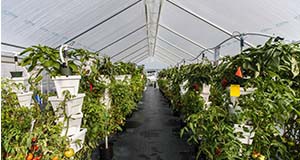
Many small farms are implementing greenhouse hydroponic systems. Perhaps the most challenging aspect of crop management for smaller growers is the control of water and nutrient delivery in a soilless media system. This six-page fact sheet focuses on relatively inexpensive strategies to help small growers know both when to start irrigation events and how long to run a single event when growing in soilless media. Written by Robert C. Hochmuth, Natalie B. Parkell, Wanda L. Laughlin, and Sean C. Rider, and published by the Horticultural Sciences Department.
http://edis.ifas.ufl.edu/hs1274
Tag: Suwanee River Valley Region
Economic Contributions and Ecosystem Services of Springs in the Lower Suwannee and Santa Fe River Basins of North-Central Florida
 This study examined the economic contributions, consumer surplus, and ecosystem services provided by recreational use of fifteen major springs sites in north central Florida. The estimated annual economic contributions of springs-related recreational spending in north-central Florida for FY 2012/13 are summarized. Among the findings, there was $84.2 million in total visitor spending for springs recreation, and 1,160 full- and part-time jobs. This 4-page fact sheet was written by Tatiana Borisova, Alan W. Hodges, and Thomas J. Stevens, and published by the UF Department of Food and Resource Economics, April 2015.
This study examined the economic contributions, consumer surplus, and ecosystem services provided by recreational use of fifteen major springs sites in north central Florida. The estimated annual economic contributions of springs-related recreational spending in north-central Florida for FY 2012/13 are summarized. Among the findings, there was $84.2 million in total visitor spending for springs recreation, and 1,160 full- and part-time jobs. This 4-page fact sheet was written by Tatiana Borisova, Alan W. Hodges, and Thomas J. Stevens, and published by the UF Department of Food and Resource Economics, April 2015.
http://edis.ifas.ufl.edu/fe958
Stewardship Ecosystem Services Study Series: Assessing Forest Water Yield and Purification Ecosystem Services in the Lower Suwannee River Watershed, Florida
 Land-use decisions and ecosystem characteristics affect the amounts of nutrients that end up in water bodies and the ability of the land to provide ecosystem services. Water quality is also highly valued by Florida forest landowners and managers. So, understanding the role of land use and forest cover and types, management practices, and conservation programs in reducing nutrient pollution will allow landowners, forest managers, and policy makers to make informed and better management decisions. In this 6-page fact sheet, we present the results of a study that used easily available models and information to assess the role of forests in providing ecosystem services, including water quality improvement or purification. Specifically, this assessment used available geospatial data and the InVEST Water Purification model to estimate how forest vegetation and soils purify water through the retention, and subsequent export, of nitrogen and phosphorus polluted runoff. Written by Sonia Delphin, Francisco J. Escobedo, Amr Abd-Elrahman, Alison E. Adams, Jackie Martin, Ronald Cademus, and published by the UF Department of School of Forest Resources and Conservation, January 2014.
Land-use decisions and ecosystem characteristics affect the amounts of nutrients that end up in water bodies and the ability of the land to provide ecosystem services. Water quality is also highly valued by Florida forest landowners and managers. So, understanding the role of land use and forest cover and types, management practices, and conservation programs in reducing nutrient pollution will allow landowners, forest managers, and policy makers to make informed and better management decisions. In this 6-page fact sheet, we present the results of a study that used easily available models and information to assess the role of forests in providing ecosystem services, including water quality improvement or purification. Specifically, this assessment used available geospatial data and the InVEST Water Purification model to estimate how forest vegetation and soils purify water through the retention, and subsequent export, of nitrogen and phosphorus polluted runoff. Written by Sonia Delphin, Francisco J. Escobedo, Amr Abd-Elrahman, Alison E. Adams, Jackie Martin, Ronald Cademus, and published by the UF Department of School of Forest Resources and Conservation, January 2014.
http://edis.ifas.ufl.edu/fr385